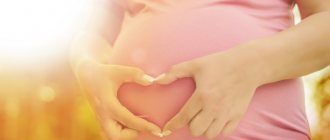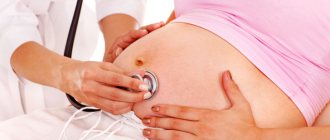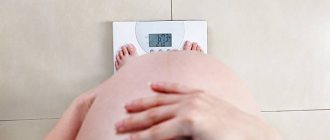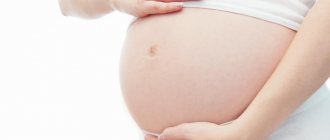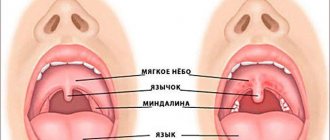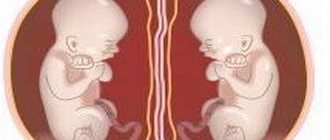Sleeping position during pregnancy is the key to the health of the baby and the good mood of the mother!
Content:
The time of “in an interesting position” for girls is the most difficult period in life. After all, carrying a long-awaited child is associated with discomfort and limited movement.
For an expectant mother, sleep is the key to the baby’s health. Inadequate rest has a bad effect on both the mother and her child. Choosing the right sleeping position during pregnancy will help solve this problem.
The womb of a mother is like a whole universe for a child, he grows there, gains strength, plays. But the mother herself experiences discomfort and pressure in the abdominal area. But the torment does not end there; the girl often suffers from heartburn, intestines, and frequent urination, especially at night. This entire list complements poor sleep times during pregnancy, especially in the later stages.
The hardest thing is for girls who like to sleep on their tummy. When the tummy appears, it is forbidden to be on it, as you can injure the baby or harm his health.
If there are pathologies, expectant mothers are strictly prohibited from even lying on their back from the first months. During sleep, the body should be relaxed to restore the strength spent during the day, and pregnant women should control their position throughout the night. Because of this, there is a lack of sleep, which is why pregnant women are often tired, sometimes even angry. This behavior negatively affects the psyche of both mother and baby.
Healthy sleep during pregnancy is essential. To do this, you need to know what sleeping position during pregnancy will be optimal. After all, a tired mother harms not only herself, but also the baby. With this in mind, we’ll figure out how to choose the right sleeping positions.
Third trimester
At this time, the woman’s body effectively prepares for labor. What week does the 3rd trimester begin? From the 25th week you can already count the days until the baby arrives. The end of the 3rd trimester is the 42nd week.
By the 27th week, the baby’s weight is about 1 kg and his height is 35 cm. When a woman is already 28-29 weeks pregnant, the baby effectively gains weight and develops subcutaneous fat. You can forget about a restful sleep, because the baby is actively moving.
A comfortable sleeping position for pregnant women, when the whole body is resting!
The first trimester – it’s comfortable to sleep even on your stomach!
Choosing a sleeping position during pregnancy is difficult, it all depends on the stage you are in. In the first weeks, every mother can sleep without thinking about anything. The only hindrance is toxicosis and psychological stress.
The body itself refuses healthy sleep. At night a depressive state sets in, and during the day I am tormented by fatigue. Hormones don’t give you a moment’s rest, but it is during this period that you have a chance to enjoy rest on your tummy - this is a comfortable position for sleeping during pregnancy. But the first trimester is not so long; in the second period you need to very carefully choose positions to rest.
The second trimester is time to change habits!
At this time, toxicosis subsides, morale stabilizes, and it would seem that everything is fine, you can sleep soundly and healthy. But this period is overshadowed by the rapid growth of the baby, and therefore the abdomen.
At this time, it's time to change all your habits. You need to start walking more carefully, holding your belly, resting more often, choosing positions so that the body rests, and not carrying heavy things. In the second period, you can no longer lie on your tummy or back.
Third trimester - you'll have to be patient!
A very difficult period is the third trimester. The abdominal cavity increases to its maximum extent; it is not only impossible, but also impossible to sleep on.
The position “on the stomach” and “on the back” is strictly prohibited; this can greatly harm the health of the little one. The ideal position for sleeping during pregnancy, according to gynecologists, is the position on the left side.
No person can lie motionless all night; doctors advise alternating between the left and right sides while sleeping. It is advisable to get used to lying on the left side, in the letter C, starting from the first months, so that later it will be easier.
For swelling of the legs, doctors recommend placing a pillow under the legs. For a good rest, it is advisable to buy a special pillow; it will be a great help when choosing a sleeping position. It is suitable for any stage of pregnancy. With its help, you will be able to rest comfortably, the spine will take a break from the heaviness, and the pressure will be relieved from the bladder and intestines. If you don't want to spend money on a special pillow, then go for a simple one. Place one of them under your stomach, the second between your knees. This position will cover your tummy and relieve pressure from the spine. If it’s slightly uncomfortable, try in this position, bending your right leg and straightening your left.
Choose the most comfortable position for you and your baby. If, during sleep or while resting, you feel that the baby is starting to kick, this is a signal that you urgently need to change your position. When the little one does not have enough oxygen, he gives signals that the pressure needs to be reduced.
By sitting half-sitting, it is easy to relieve tension from the body and fall asleep. When choosing sleeping positions during pregnancy, expectant mothers will have to experiment all the time and choose positions that suit your baby and ensure a good supply of oxygen and nutrition to the fetus. The nutrition of the placenta and baby depends on this.
Using a roller will help a lot. Place it under your back, in the lumbar region, to relieve pressure on the spine. After a long day, due to carrying weight, it is necessary to unload the body and give it a good rest.
Features of the first trimester
During this period, the birth and initial development of the baby occurs. The fertilized egg moves through the fallopian tubes. It appears in the uterus 7-8 days after conception. Then the active formation of the embryo begins. By the end of the third week, the size of the unborn child is 2 mm. On the fourth stage, the embryo’s heartbeat is heard.
In the sixth week, the rudiments of the nervous and digestive systems are formed. Also during this period, the initial elements of the brain begin to develop. At the eighth week, the baby already has limbs, a head and a face.
Note. At this stage of the child’s development, doctors recommend general tests and ultrasound. This will allow us to identify various abnormalities in the development of the fetus and eliminate them in a timely manner.
Ninth week – kidney development. Already at 12-13 weeks the baby is actively bending and unbending his limbs.
The dangerous periods of this trimester are weeks 8-12. If a woman's placenta does not develop, the fetus may die. To prevent these irreversible consequences, it is necessary to be constantly monitored by a doctor. Nowadays, such a deviation in a woman’s body can be easily treated with medications.
These poses should be avoided during pregnancy!
In order not to harm the baby, you need to remember a few simple rules and follow them. From the first months you should avoid resting on your abdomen and back.
In the first trimester you can still sleep like this, but it is best to immediately develop a habit, because when your tummy gets bigger, you always want to lie on it. It is prohibited to be on the womb due to the pressure on the child. The mother's weight is much greater than the baby's weight; sleeping on the abdomen puts a lot of pressure on the baby.
You can't lie on your spine either. After all, when you rest on your back at night, the uterus puts pressure on the spine, intestines, arteries and other organs. This position also limits the supply of blood, oxygen, and nutrition to the placenta and fetus. Long periods of sleep on your back lead to swelling of the legs and pain in the vertebrae. You may even wake up at night with severe lower back pain. This means it's time to lie down differently. Make sure you spend very little time on your back. There is no need to make a cult out of this and come up with supernatural poses, because the most important thing is your comfort and healthy rest. If you previously had a very hard surface, then buy a softer mattress. We also do not recommend sleeping on your right side. Temporarily, changing the left to the right side is possible, but not all night. Your little one will warn you about this. If you are comfortable, you can calmly lie in this position, but if blood circulation is impaired and the arteries are compressed under the pressure of the uterus, the baby will begin to kick, and you yourself will change position.
There is no need to torment yourself with insomnia and try to control every movement. Sleeping position during pregnancy is also controlled by nature. The female body is designed in such a way that if your child doesn’t like something, he will warn you about it with painful jolts. Basically, a pregnant woman herself will not be able to lie on her right side for a long time. After all, the baby’s position in the tummy is such that he often kicks to the right side. Therefore, the choice of posture on the left side even arises due to a physiological factor.
Pregnancy is an amazing period of life; if a position can cause harm to your baby, then the mother herself will not be able to be in such a position. Therefore, you need to learn to listen to your body.
Overall maternal and fetal health
Visits to the gynecologist in the third trimester become significantly more frequent. Now you have to visit him 2 times a month and it would be nice to find out in advance what tests you need to take in the third trimester. You need to take all the same tests that you took at the beginning of your situation. These are: blood test, total protein test, blood sampling from a vein (blood for syphilis). A urine test for total protein will help timely identify gestosis, preeclampsia, and also determine the amount of salts in the urine, which accompanies the condition of your kidneys.
A blood draw checks the number of red blood cells, white blood cells, and hemoglobin in the blood. It is very important to monitor hemoglobin in the blood; it is responsible for the health of not only the mother, but also the fetus.
The natural process is that hemoglobin decreases by 34 weeks of pregnancy, this is due to an increase in blood volume, but not an increase in red blood cells. So, with low hemoglobin, doctors advise taking vitamins and foods containing iron. A decrease in hemoglobin can lead to anemia, and this is contraindicated. Still, it cannot be said that the mother’s body and the survival of the fetus are not in danger.
About sitting position during pregnancy
Experts say: maintaining a sitting position for a long time will not benefit a pregnant woman and her baby. In a sitting position, only some muscle groups are constantly working, while others are in a relaxed state. That is why pregnant women are not recommended to sit at work, which requires maintaining a stationary position for a long time.
Negative consequences of prolonged sedentary work:
- the load on the gluteal muscles increases;
- back muscle activity decreases;
- increased pressure on the intervertebral discs in the lumbar region;
- the blood supply to the pelvic organs and lower extremities is disrupted;
- blood flow through the placenta to the fetus slows down;
- the risk of developing edema of the lower extremities increases.
Prolonged maintenance of a sitting position provokes an exacerbation of osteochondrosis and the development of an intervertebral hernia. Over time, pain appears in the lumbar region and discomfort in the lower extremities. Due to impaired blood flow, changes in blood pressure, headaches, and dizziness are possible. All this significantly worsens the condition of the expectant mother and interferes with the normal course of pregnancy.
Sedentary work is a risk factor for the development of varicose veins of the lower extremities and pelvis. The likelihood of developing such complications increases in the second half of pregnancy. The resulting stagnation of blood in the pelvic organs leads to the appearance of hemorrhoids, spider veins and dilated veins in the legs. The risk of developing thrombosis in pathologically altered veins increases significantly.
Serious problems arise in the second half of pregnancy after 24 weeks. When sitting for a long time, the pressure of the growing uterus on the pelvic organs and spine increases. Blood flow in the pelvic cavity is disrupted, and the supply of oxygen and nutrients to the fetus deteriorates. Constant sedentary work in the third trimester is a risk factor for the development of placental insufficiency and other pregnancy complications.
one moment, please
The third trimester is rarely easy. Pregnancy is nearing its end, but every day it becomes harder for the woman. The uterus has already reached a large size, so it takes up a lot of space in the abdominal cavity. The functioning of internal organs deteriorates, as their normal location is disrupted.
Third trimester
1.How does your lifestyle change in the third semester?
The third trimester is rarely easy. Pregnancy is nearing its end, but every day it becomes harder for the woman. The uterus has already reached a large size, so it takes up a lot of space in the abdominal cavity. The functioning of internal organs deteriorates, as their normal location is disrupted.
Therefore, in the third trimester it is best to lead a calm and measured life, avoid long walks, travel and flights. You should not visit places where there are a large number of people (cinemas, exhibitions, restaurants). If you really want to go, then you need to choose a time and place so that it is not very busy.
2. What daily routine should you have in the second half of pregnancy?
At 30 weeks, a pregnant woman goes on maternity leave. This period was chosen for a reason. It was from this time that it became increasingly difficult for a woman to fulfill her duties, both official and domestic. Therefore, it is better to exercise your right to go on maternity leave at 30 weeks. But if your health condition allows, you can take out a certificate of incapacity for work later. On maternity leave, a woman has complete control over her time. We need to focus on how we feel. If you want to sleep, if you want to eat. You should not overeat throughout pregnancy, especially in the third trimester. Eating too much can lead to stomach pain, vomiting, shortness of breath and even heart pain. Therefore, you need to eat often in small portions. Sleep at least 8-9 hours at night. Daily walks in the morning and evening are also required. You cannot limit yourself in movement.
3. Is it possible to have sex in the third trimester?
During this period, sexual intercourse is allowed during a normal pregnancy, but you must behave carefully and carefully. Sometimes too much sex in the third trimester can cause premature birth. During orgasm, involuntary uterine contractions occur. The closer the due date, the more ready a woman’s body is for childbirth. Any provoking moment can cause contractions. Despite the small risk, sexual desire remains in many women, and for some it weakens, especially shortly before childbirth.
4. How to behave when in contact with sick people?
For the entire period of pregnancy, it is worth limiting contact with people who may be potential carriers of the infection. If a pregnant woman works in a public place, then you can use a mask during a flu epidemic, put oxolinic ointment in your nose, or take sick leave in order to protect yourself and your child from influenza or ARVI. If you know in advance that a friend or relative is sick, then you should not meet with him until he recovers.
5. How should you care for your breasts in the third semester?
The breast is already ready for its main function, so even if labor begins prematurely, the baby will not lack breast milk. In order to create an adequate reaction in the nipples to the sucking process in the third trimester, it is recommended to do an exercise - squeeze the base of the nipple with your thumb and forefinger. It must be compressed rhythmically in the horizontal plane, and then in the vertical. If you have flat nipples, you can start using nipple formers from 32 weeks. Massaging the nipples with a hard towel should be done before 36 weeks of pregnancy. After this period, the connection between the breast and the uterus becomes very strong, and nipple irritation can lead to childbirth.
6. What causes lower back pain and how to deal with it?
During pregnancy, the load on the spine changes, the center of gravity changes, so a “duck” gait specific to pregnant women appears. All this negatively affects the condition of the intervertebral cartilage, ligaments and muscles in the back. Therefore, at the end of the day, a woman experiences aching back pain. To prevent these pains, it is recommended to avoid wearing high-heeled shoes. Using a maternity bandage helps a lot. It supports the abdomen and strengthens the lower back, thereby reducing the load on the spine. Also, the use of a bandage helps prevent stretch marks on the skin and divergence of the rectus abdominis muscles. You can't wear it all the time. It is recommended to take a break of 30 minutes every three hours. It must be removed at night.
7. Why do dental problems occur and how to avoid them?
During the first half of pregnancy, teeth rarely bother a woman, especially if they were in good condition before pregnancy. But after 20 weeks, active growth of the fetus in length begins, so an increased amount of calcium and fluoride is required for the formation of fetal bones. If these essential microelements are not enough in the mother’s blood, they begin to be washed out of the woman’s bones and teeth. In this case, the appearance of caries is guaranteed. Prevention is the timely intake of complex vitamins for pregnant women or separately calcium and vitamin D3 supplements. If problems with teeth appear, there is no need to postpone their treatment until the postpartum period. Small caries during pregnancy quickly turns into a big problem, since calcium consumption is very high. Anesthesia and modern materials are safe for the fetus, so teeth should be treated immediately after identifying the problem.
8. How to cope with depression and low mood in the last stages of pregnancy?
Feelings of fear, panic and fatigue often overwhelm a woman in the last trimester. This is a completely natural reaction, especially in primigravidas. Their lives have already changed, and not yet for the better. The feeling of helplessness, constant health problems (constipation, heartburn, varicose veins, large weight gain) and fear of the upcoming birth do not allow one to live in peace. Therefore, most expectant mothers begin to become depressed. This condition must be combated with the help of walks, a pleasant and relaxing holiday with the family. More time should be devoted to preparing for the upcoming birth of the baby. Typically, women who independently buy things for a child are more relaxed and cheerful, since nothing lifts the mood better than shopping for a baby. The main thing is to remember that pregnancy does not last forever, and the meeting with the child is already close.
9. What to do if the baby is in a breech position?
Malpresentation of the fetus is most often corrected after 30 weeks of pregnancy. If the baby has not turned head down before 36 weeks, then all factors must be assessed and the issue of delivery must be decided. Sometimes a caesarean section is required (large fetus, narrow pelvis or complicated pregnancy), sometimes vaginal delivery is possible. If on an ultrasound scan at 32 weeks the fetus is head down, then the pregnant woman is asked to perform a set of exercises to transfer the baby from a breech presentation to a cephalic presentation. Sometimes a procedure is prescribed - external rotation on the head. It is carried out under ultrasound control. But the turn has many contraindications, so it is rarely performed.
Choosing a pose
Comfortable sitting positions for pregnant women:
- Option number 1 . Sitting on a chair, rest your back against a support. Make sure your back is tightly against the back of the chair. The neck and shoulders at this moment should be on the same axis with the spine. Your legs should be level, supported on your toes and heels.
- Option number 2 . Sit on the seat without touching its back with your back. Position yourself so that your buttocks rest completely on the seat. Relax: there should be no tension in your legs and buttocks.
- Option number 3 . Sit cross-legged (Turkish style). Position yourself so that your body weight rests on your sit bones. Watch your posture: your back should be straight, your head and neck should be on the same axis with your spine. The pose is suitable for sitting on the floor, sofa or other wide, flat surface.
The proposed poses are considered the most physiological. They do not interfere with normal blood flow in the pelvic organs, help to evenly distribute the load on muscles and ligaments, and help maintain posture and ensure proper rest. Such positions do not interfere with the normal course of pregnancy and fetal development.
Nutritional features in the 3rd trimester
When the stomach drops, the heaviness in the stomach and heartburn go away, a woman’s appetite improves, and a desire arises to eat “something harmful and forbidden.” We advise you not to get carried away; additional stress on the liver and pancreas is completely unnecessary now. No, one cake will not harm you and your baby, but you should know when to stop.
Eat as before, in small portions. To get the vitamins and minerals you need, include the following foods in your diet:
- fresh vegetables and fruits, leafy greens;
- fermented milk products and eggs;
- nuts, dried fruits, vegetable oils;
- lean meat and fish;
- oatmeal, brown rice, millet, buckwheat and other grains.
Limit your consumption of potatoes, confectionery and flour products - sources of simple carbohydrates. Avoid alcohol, carbonated drinks, fried and smoked foods.
Meat, fish and eggs must undergo sufficient cooking. Avoid soft-boiled eggs or medium-rare steak. This will protect you from listeriosis, an infection that has serious consequences for the fetus.
Important aspects
When choosing a comfortable sitting position, you need to consider the following points:
- When sitting on a chair, your legs should fully reach the floor, resting your toes and heels on the surface. You should not cross your legs, bend them under yourself, or throw one leg over the other.
- The seat for the expectant mother should be moderately rigid and not sag under her weight.
- For convenience, you can place a cushion or pillow under the lumbar region. Special pillows for pregnant women will come to the aid of the expectant mother, designed to relieve the load on the spine.
- In the Turkish position, you should carefully monitor your well-being and the sensation in your legs. Unaccustomed to this position, your legs become numb, and unpleasant sensations appear in the form of goosebumps and numbness.
- From time to time you should change your position, stand up, walk around the room.
- Convenient hand placement is the key to comfort. Hands should be relaxed. While sitting on a chair, your hands can be folded in front of you on your knees, placed on the table or armrests.
Basic recommendations
To make the entire 3rd trimester of pregnancy as easy and comfortable as possible, it is advisable to adhere to the following recommendations:
- Since both mother and unborn baby need oxygen vitally, they should spend as much time as possible in the fresh air. Walking can be very useful, but you can only give it up in very bad weather. How many kilometers an expectant mother can walk in the last months of pregnancy can be checked with a doctor, who will be able to provide a recommendation taking into account the peculiarities of the course of pregnancy.
- It is necessary to properly care for the nipples of the mammary glands. Since a small amount of colostrum is regularly released from them, cotton inserts, which you can make yourself, should be placed in the bra cups. In addition, water procedures for this part of the body should be performed more often.
- Don't forget about correct posture. You can only lean forward a little when walking on a slippery or unstable surface in order to maintain your balance. You should sit or stand with a straight back and neck, this will also help reduce back pain.
- To avoid leg swelling, you can perform special exercises. You should also place your legs in a horizontal position more often to normalize blood circulation.
- To reduce lower back pain, you should sleep on a moderately hard mattress, do not lift heavy objects, and do not stay in one position for a long time.
- During the entire third trimester of pregnancy, it is better for the expectant mother to have all the necessary documents with her when away from home. Therefore, when going outside, even to the nearest store, you should put your passport and other documents necessary for registration at the maternity hospital in your purse. Such precaution will never be unnecessary, because there are known cases when women experienced rapid labor. And without the necessary documents, it may be difficult to register with the desired medical institution.
Since there is not much time left until the long-awaited moment of childbirth, it is worth taking full advantage of maternity leave and having a good rest: getting plenty of sleep, watching your favorite films, enjoying solitude or communication with family and friends, because after the birth of the baby you will have to postpone such joys for several months.
Security measures
Pregnant women are not recommended to remain stationary for long periods of time. Every 30-45 minutes you need to take a break: get up, change your position. After 30 weeks, a break will be required every 15-20 minutes or as needed.
When changing positions, you should do simple gymnastics:
- Walk barefoot on the floor.
- Quickly clench and unclench your toes.
- Try to grab a small object from the floor with your toes.
- Make several slow circular movements with your feet.
- Roll from heel to toe and back until the tension in your legs subsides.
It wouldn’t hurt to do a warm-up for other muscle groups:
- Make some rotational movements with your head and shoulders.
- Stretch your hands.
- Gently stretch your entire body upward.
- Spend 30-60 seconds stretching your arms forward and relaxing your back.
These simple exercises will help normalize blood flow in the pelvic cavity, tidy up the muscles and ligaments and relieve stress from the spine.
Heartburn:
Reasons for appearance
The action of progesterone when the acidic contents of the stomach are thrown back into the esophagus.
Squeezing. The grown uterus puts pressure on the stomach and intestines from below, causing food to flow back into the esophagus.
Gaining weight creates an increase in pressure in the peritoneum.
How to fix
Small portions of food after 2 hours. Products with an alkaline reaction (milk, cottage cheese, fish, boiled and baked vegetables, mineral water).
Diet: exclude fatty fried, smoked, spicy, carbonated foods. If diet does not help, Gaviscon is prescribed. Rennie. Soda solution.
Sleep on your left side.
How to sit correctly during pregnancy
Good posture is extremely important for the health of any person. During pregnancy, its value doubles. Incorrect body position can lead not only to discomfort and pain, but even to injury or harm to the child. Thus, due to poor posture, blood circulation is impaired by the fetus and may receive less nutrients and oxygen. And for the expectant mother herself, the habit of sitting incorrectly, for example, can be fraught with the occurrence of congestion in the pelvic area, hemorrhoids, edema, etc. To avoid all these problems, maintain a healthy pregnancy and stay in shape, you need to learn how to walk and sit correctly and lie down.
What happens in the third trimester
In the last 3 months of pregnancy, the uterus increases significantly in size.
The stomach becomes bulging. It becomes more difficult for a woman to move and perform usual actions, because her large belly makes it inconvenient for her to bend over, turn, or walk quickly. See also:
Second trimester of pregnancyPregnancy calendar
9th week of pregnancyPregnancy calendar
16th week of pregnancyPregnancy calendar
The photo shows the burden women have to carry during this period.
Despite some difficulties, in the third trimester of pregnancy a woman feels much better psychologically, because a baby born at this time has every chance of survival.
Nevertheless, saving the life of a newborn, especially one born at the very beginning of the final trimester, up to 32 weeks, is possible only with the use of special equipment. Therefore, the expectant mother is not recommended to make long trips to remote areas during this period.
A woman’s body is gradually preparing for the process of childbirth: the pelvic bones soften and move slightly apart, and the volume of discharge from the mammary glands increases. The important stage of choosing a maternity hospital and collecting all the necessary things and documents that will be useful in the maternity hospital begins.
What should you avoid while sitting during pregnancy?
There are a number of things that a pregnant woman should avoid when sitting.
- Slouch. A curved spine puts additional stress on it, which can increase back pain. In addition, this body position limits free breathing.
- Dangling legs. Swelling of the legs is a common problem faced by women during pregnancy. Its appearance is promoted by constant sitting in a position with suspended legs.
- No backrest. A pregnant woman's back needs support while sitting to relieve stress on the spine. Otherwise, back pain may worsen. You should avoid sitting on a chair without a back or with a low back.
- Bend forward. Leaning forward while sitting puts excessive pressure on the abdomen, which negatively affects the fetus. In the later stages of pregnancy, the mother's chest can touch the baby's soft bones and affect their structure.
- Sitting on the edge. When a woman sits not completely on the surface, but on its edge, this increases pressure on the spine and contributes to pain.
There are other undesirable sitting postures that a pregnant woman needs to pay attention to. For example, it is not recommended to sit with your legs crossed. This may increase ankle swelling or varicose veins due to decreased blood flow. If you need to turn around, it is advisable to turn your entire body, not just your torso. Body position should be changed regularly. You need to stay in one position for a maximum of 15 minutes.
It's time to prepare for childbirth
Movement is life, even in the 3rd trimester; don’t sit on a cozy sofa, walk around the apartment, take a walk in the fresh air.
Doctors advise giving the body light loads, they will not harm even if you have a large belly: moderate yoga, gymnastics for pregnant women (for example, with a fitball - a large soft ball) will prepare the muscles for childbirth.
Simple exercises with a fitball will improve the health of the expectant mother before giving birth
Other recommendations from doctors:
- do a set of Kegel exercises - increase the elasticity of vaginal tissue, which will make childbirth easier;
- Massage the nipples 2-3 times a day - this causes additional synthesis of the hormone oxytocin, which regulates uterine contractions;
- to prevent a large number of ruptures during childbirth, massage the perineum with oils in the evening, after a warm shower; however, such a massage is contraindicated if the mother is at risk of premature birth, if the woman has vaginitis, genital herpes, thrush and other genital infections.
In the 3rd trimester, doctors do not prohibit sex: it relieves stress, improves well-being, stimulates blood flow to the uterus, and therefore provides an additional portion of oxygen to the baby. Just choose the right poses - without putting pressure on your stomach.
On the table of the expectant mother, the main place is for vegetables and fruits; stew, boil, bake dishes. Give up tasty but harmful foods for a while - for the sake of your baby.
Video: advice from doctors for mothers in the 3rd trimester
What to consider about sitting during pregnancy?
Sit correctly
- While sitting on a chair, you need to keep your back straight and your shoulders back. The head and neck should be on the axis of the spine.
- The knees should be at right angles to the pelvis. In addition, the buttocks should be completely positioned on the surface of the chair, so that they are in a relaxed state and touch the back. The feet should be completely flat on the floor, so that the calves do not experience any tension. The weight should be balanced and evenly distributed on both gluteal muscles, not weighted to one side or the other, so as not to put pressure on one particular limb.
- If you are sitting on a swivel chair with wheels, you should be careful not to try to turn it using the force of the body itself. The turning movement must be carried out with the whole body.
- To support your back, the best option would be to place a bolster, pillow or rolled towel under your lower back.
- If you need to work while sitting for a long time, you need to adjust the height of the chair accordingly and place it closer to the table. This will protect the pregnant woman from exposure to the baby. In addition, it is necessary that in this case the chair has armrests, then the shoulders and elbows will be more relaxed.
Change your body position
- As mentioned earlier, you should never sit in the same position for long periods of time during pregnancy. The body may feel discomfort and stiffness. A woman should learn to listen to his needs and find out what best affects his well-being. And one of the most important factors in this matter is, of course, proper blood supply to the whole body. The expectant mother should make it a habit to get up every 30 to 60 minutes to stretch or just walk around. This relaxes the muscles and restores blood flow.
- In addition, a pregnant woman should not slouch while sitting on a chair or sofa. This position of the body can cause the fetus to take an incorrect position. At least in the later stages of pregnancy, this can be problematic as it can complicate labor.
- To get up from a sitting position, you should first move to the very edge of the chair, then stand up, straightening your legs. Avoid bending your body forward at the waist. Immediately straighten your back.
Practice beneficial yoga poses
Cobbler's pose is great for sitting on the floor or a large surface (bed, etc.) during pregnancy. This is one of the recommended yoga poses (asanas) for pregnant women. You need to sit with your back straight, your knees bent, and your feet together. You should place a special yoga mat or blanket under your buttocks. This position, along with others, is great for preparing the body for childbirth. By using it every day during the second and third trimesters of pregnancy, you can help ease the labor process.
Sit and buckle yourself correctly in the car
- When driving, you should be careful when using seat belts. The lap belt should not be fastened too tightly and should go just below the abdomen so as not to put pressure on the fetus. The shoulder strap must be positioned so that it does not put pressure on the mammary glands.
- Back support is still recommended when driving. Your knees should be at hip level or even slightly higher. The seat of the chair should be moved close to the steering wheel enough to prevent the need to lean forward; this will also allow your feet to reach the pedals easily. With the correct body position, the stomach of a pregnant woman should be located at a distance of 25 cm from the steering wheel. But it is better to avoid driving altogether in the last trimester of pregnancy to avoid trouble.
Use a fitball for pregnant women
Sitting on this large gymnastic ball helps the female body cope with the difficulties of pregnancy. Exercises with it relax the muscles of the lumbar region, improve blood circulation, and reduce back pain. A fitness ball should be selected according to your height. By practicing sitting on it daily, a woman strengthens the muscles of the pelvis, back and abdomen. This is especially useful in the last trimester. These exercises also help position the fetus in the correct position during the prenatal period. Fitballs can even replace regular chairs in the workplace. They are also called medicine balls or birthing balls. Birthing balls are made with a special non-slip finish. This gives the ball better grip on the surface, preventing the expectant mother from slipping or falling while sitting. 1
Tests and ultrasound
At the beginning of the third trimester of pregnancy, when you apply for maternity leave and receive an exchange card in your hands, you will have to undergo an extensive list of tests and re-consult with a therapist, as prescribed - with an ophthalmologist and other specialists.
List of studies in the 3rd trimester of pregnancy
- general blood test and biochemistry;
- clotting test;
- blood testing for HIV, AIDS, sexually transmitted infections and hepatitis;
- microflora smear.
As before, before each visit to the gynecologist, you take a general urine test and perform a CTG test to assess the fetal heartbeat.
Ultrasound in the third trimester
Performed at 30-32 weeks together with Doppler ultrasound - examination of the blood vessels of the umbilical cord, uterus and fetus. During an ultrasound, a specialist measures the length of the limbs, circumference of the head and abdomen, approximate weight, height and type of presentation. He is also interested in the amount of amniotic fluid to exclude polyhydramnios or oligohydramnios, and the condition of the placenta. The results largely influence the choice of delivery method and determine the need for early hospitalization of the pregnant woman.
Other Helpful Positions During Pregnancy
Standing position:
- keep your head straight, trying not to tilt or stick your chin forward;
- shoulders - back, chest - forward;
- stand on straight legs, but avoid rigid fixation;
- straighten up as if you were stretching your head towards the ceiling;
- distribute your weight on both legs without shifting from one foot to the other;
- wear low heels (but not flat shoes);
- do not stand for a long time, it is harmful to the spine and blood flow in the legs;
- If you are forced to stay in a standing position for a long time, place your legs alternately at intervals of several minutes on a chair, step, box, or the like.
Lying position:
- It is best to sleep or lie down so that only your head is on the pillow, but not your shoulders;
- choose a pillow that is not too voluminous to avoid back strain;
- rest lying down, preferably on your side, with your knees slightly bent, without pulling them to your chest; place a pillow between your knees for comfort;
- Avoid lying on your stomach completely and minimize lying on your back;
- Use a fairly firm mattress that does not sag under your weight.
Picking up objects:
- When lifting objects, avoid heavy objects (more than 9 kg);
- Before lifting anything, make sure you are in a stable position;
- if the object is much below waist level, keep your back straight, and then bend your knees, redistributing your body weight on them without bending at the waist.
- stand with your feet wide apart, as close as possible to the thing that needs to be lifted;
- lift using the strength of your leg muscles;
- when unbending, remain stable and avoid twisting the body;
- when lifting an object from a table, move it to the edge closer to you, bend your knees to get closer to it, then use your leg muscles to lift the object and return to a standing position;
- do not lift heavy objects above waist level;
- When carrying bags, hold them close to your body with bent arms, take small steps and walk slowly;
- while lowering the object, also take a stable position, then bend your knees. (2)
The longer the pregnancy, the more a woman is supposed to rest. Therefore, at home, keep your sitting and standing positions to a minimum. Instead, it is better to lie down with your legs higher than your chest. If you continue to work, take breaks to warm up or stretch as often as possible. 2
Fetal development
The fetus continues to develop and every day becomes more prepared for birth. The longer the pregnancy, the better developed the respiratory, digestive and other systems of the baby’s body.
In the seventh calendar month of pregnancy, a number of changes are characteristic of the fetus’s body:
- Sense organs are actively developing. The fetus is able to clearly taste the amniotic fluid, sense certain odors, and respond to external lighting and various sounds. He may express his dissatisfaction with the bitter taste of amniotic fluid or too loud music with strong and decisive thrusts.
- The process of active accumulation of subcutaneous fat continues.
- The cerebral cortex is being improved.
- Pain receptors are developed, so the baby can feel pain.
- The baby's autonomous metabolic regime is formed.
At the eighth month of development, the condition of the fetus can be characterized as follows:
- The baby becomes less active, because he is already quite cramped in the uterus.
- As a rule, at 8 months the fetus has already assumed a head-down position in the stomach.
- The size of the fetal brain during this period is ¼ of the mass of the adult brain.
- The urinary system is formed, which means that the fetal body can produce urine.
- The original lanugo fluff disappears on the body.
- The cornea of the eyes begins to take on a light blue tint.
- The baby's skin gradually smoothes out, but retains its original lubricant.
In the ninth month of development, new changes occur in the fetal body:
- The baby's lungs become more mature and are almost ready to work independently.
- Brain neurons are surrounded by a special protective myelin sheath.
- The cartilages of the nose and ears become stronger.
- In boys, the testicles descend into the scrotum.
- Original feces - meconium - have already formed in the intestines.
- Nails become long and begin to protrude beyond the edges of the fingers.
- Many babies start growing hair on their heads in the ninth month.
- The epithelium has already formed in the intestines.
- The stomach is able to begin producing enzymes that are necessary for the normal digestion of breast milk.
- The skin tone becomes light pink.
Overeat
In the third trimester, the belly is actively growing, so it is recommended to eat small portions, but often. As soon as a pregnant woman overeats, it will be difficult to breathe and move. By the way, a common problem during this period is heartburn. It can be avoided if you build a balanced diet without fast food, fried, smoked and harmful foods. After eating, it is also not recommended to immediately lie down on the sofa or bed. The consumption of salty foods should also be limited. A common problem in the third trimester is swelling, and salt retains fluid in the body.
Edema:
Reasons for appearance
Violation of water-salt metabolism. Excess fluid intake, prolonged exposure to heat, physical activity.
With high blood pressure, swelling is a symptom of gestosis!
How to fix
Control your fluid and salt intake. Rest. Foot massage. Clothes without compressive elements - elastic bands, cuffs, etc.
Do not do anything without doctor's instructions! Do not reduce your fluid intake or take blood pressure medications on your own.
